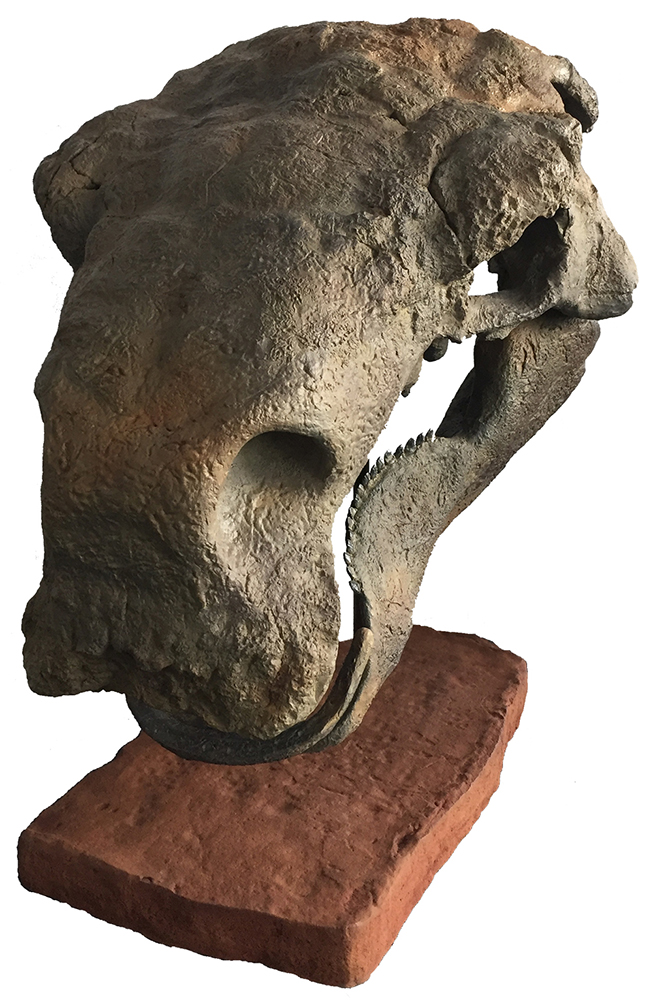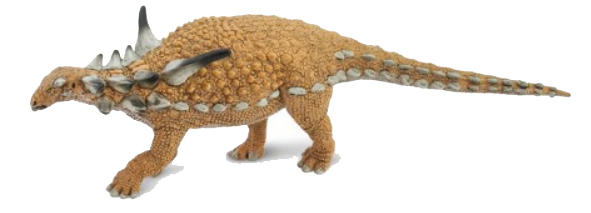Late Cretaceous (~98-93 MYA) - nodosaurid dinosaur

Peloroplites was a late Cretaceous nodosaur from Utah. Nodosaurs were relatives of the more famous armored ankylosaurs, but they did not have clubbed tails as ankylosaurs did. However, nodosaurs did have heavy body armor like ankylosaurs had, and their bony armor extended to the skull as seen here.
The name ‘Peloroplites’ comes from the Greek words for ‘monstrous’ and ‘heavily armored’ and appropriately Peloroplites was one of the largest known armored nodosaurs, growing up to six meters in length and weighing two metric tons. Although Peloroplites, lacked a clubbed tail, numerous large spikes studded its shoulders and ran down its sides and tail. Combined with its body armor, those spikes would have made Peloroplites a difficult target for predators. Especially for theropod dinosaurs, whose bipedal nature meant that any leg injury could be fatal as it could prevent them from hunting.
The skull of Peloroplites was a half meter in length and covered by layers of fused dermal armor scutes. In life, the snout would have had a keratin beak to crop plants. Keratin scales would also have covered much of the skull’s surface. The teeth lining the jaws’ sides were remarkably small and designed for slicing rather than grinding. Yet those small teeth were continuously replaced throughout the animal’s life, so Peloroplites never ran out of working teeth. With its short, squat body, Peloroplites would have fed on low vegetation, allowing it to co-exist alongside larger ornithopod dinosaurs that browsed on taller foliage and could even reach the tree canopy. Peloroplites remains are found in sediments most likely deposited in coastal fluvial environments where biodiversity would be relatively high. Hence resource partitioning was necessary to avoid competition with other dinosaur lines – including their closely related ankylosaur cousins.
Despite its massive size, the snout of Peloroplites tapers towards the front and is not as broad as in ankylosaurs. Among living forms, a narrowing snout is often associated with specialized feeding, rather than general browsing. Most nodosaurs had narrow snouts compared to contemporaneous ankylosaurs and their reliance on different resources may explain why these two broadly similar lines of low browsing, armored quadrupeds could coexist in the same areas for millions of years. Recently, stomach contents from a remarkably well preserved Borealopelta nodosaur found in Canada support the idea of nodosaurs being selective feeders. Most of that nodosaur’s last meal consisted of a single type of fern it sought out, ignoring other vegetation. Small bits of ingested charcoal suggest the animal was grazing in a recently burned area, selecting feeding on new growth ferns that colonized a burned landscape. Assuming Peloroplites had a similar lifestyle, it might have selectively browsed the foliage like modern deer do. Although Peloroplites’ teeth were small, their jaws and teeth were still more robust than those of other nodosaurs, suggesting it may have further differentiated its resource use from other nodosaurs by focusing on slightly tougher vegetation.
The small figure next to the skull is not Peloroplites, but another closely related nodosaur known as Sauropelta. In fact, some Peloroplites specimens were originally thought to be Sauropelta, although Sauropelta was a smaller, less massive nodosaur from the Early Cretaceous.
